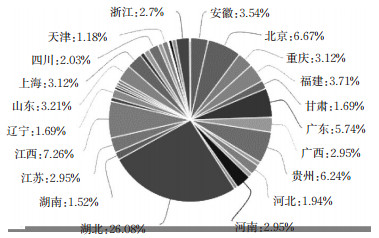An Acceptance Model and Risk Analysis of Automated Vehicles Based on SEM
-
摘要: 为了探究社会大众对自动驾驶汽车的接受度及其影响因素,通过对自动驾驶汽车的风险评估,基于TAM模型增加外部变量,改进感知易用性与感知有用性,建立自动驾驶汽车接受度研究模型。将研究模型中假设的外部变量、潜在变量、认知变量与自动驾驶汽车社会接受度的关系进行Pearson相关性与Kendall相关性检验。基于相关性检验剔除无关因素变量,建立线性回归模型,对相关因素与自动驾驶汽车接受度的关系进行了探究,并以此建立接受度结构方程模型,对各个变量与自动驾驶汽车社会接受度之间的因果关系进行了进一步研究论证。结果显示,法律伦理的认知对自动驾驶汽车接受意向产生(E =0.038,P < 0.001)显著正影响。驾龄、驾车频率对接受意向产生(E =-0.044,P < 0.001)显著负影响。学历通过促进公众对自动驾驶汽车正面的认知、抑制负面认知,从而对公众接受意向产生(E =0.172,P < 0.001)显著正影响。功能的认知会促进公众对自动驾驶汽车正面影响的认知,从而对接受意向产生(E =0.444,P < 0.001)显著正影响。Abstract: A model is developed to accept automated vehicles based on the TAM model to study public acceptance of automated vehicles and its influencing factors. The relationship among external variables, latent variables, cognitive variables, and social acceptance of automated vehicles assumed in the model is verified by Pearson and Kendall correlations. A linear regression model and an acceptance-based structural equation model are established to explore the relationships of relevant factors, various variables, and public acceptance of automated vehicles. The results show that the cognition of legal ethics positively affects the acceptance intention of automated vehicles(E =0.038, and P < 0.001). Driving age and driving frequency negatively affect the acceptance of automated vehicles(E =-0.044, and P < 0.001). Educational background has a significant positive impact on the acceptance of automated vehicles by promoting the public's positive cognition and suppressing the negative cognition(E =0.172, and P < 0.001). Functional cognition has a significant positive impact on the acceptance intention of automated vehicles(E =0.444, and P < 0.001)
-
表 1 样本主要特征信息
Table 1. Main characteristic information of samples
样本属性 组别 占比/%(N =769) 性别 男 55.4 女 44.6 年龄/岁 ≤17 0.7 18~30 71.4 >30~45 15.3 >45~60 9.5 >60 3.1 受教育程度 小学 11.3 中学 13.9 大专 11.1 本科 47.5 研究生 16.3 驾龄/年 无驾驶证 25.1 0~3 37.6 4~6 22.0 7~9 10.9 ≥10 4.4 机动车类型 普通乘用车辆 22.5 货车 9.4 PV商务车辆 6.8 UV越野车辆 11.1 摩托车 4.4 未拥有车辆 45.9 职业 政府及事业单位 11.3 企业 24.6 高校及科研机构 7.7 自由职业 8.3 无职业 2.5 学生 45.6 驾车频率 从不 31.7 偶尔 31.6 经常 26.9 总是 9.8 表 2 KMO和Bartlett的检验
Table 2. The test of KMO and Bartlett
检验方法 数值 KMO检验 0.803 Bartlett的球形度检验 近似卡方 3 142.391 df 253 Sig. 0 表 3 自动驾驶汽车社会适应性问卷表信度检验结果
Table 3. Reliability test results of the social adaptability questionnaire for Automated Vehicles
问卷项目 成分 1 2 3 4 5 1.您的学历 0.71 2.您的驾龄 0.71 3.您的驾车频率 0.73 4.您了解自动驾驶汽车吗 0.81 5.您认为自动驾驶汽车的应用是否可能减少尾气排放 0.81 6.您认为自动驾驶汽车的应用是否可能减少交通事故的数量 0.88 7.您认为自动驾驶汽车的应用是否可能缩短行程时间 0.81 8.您认为自动驾驶汽车的应用是否可能缓解交通拥挤 0.86 9.您认为自动驾驶汽车的应用是否可能提高车辆应急响应的灵敏性 0.81 10.您认为自动驾驶汽车的应用是否可能降低交通事故的严重性 0.82 11.您认为自动驾驶汽车系统在使用中是否可能被黑客入侵导致行驶安全问题 0.80 12.您认为自动驾驶汽车在使用中是否可能泄露车主的个人隐私 0.81 13.您认为自动驾驶汽车在使用中是否可能和非智能车相互干扰 0.80 14.您认为全自动驾驶汽车是否可能对人类安全构成威胁 0.82 15.您认为自动驾驶汽车在使用中是否可能对行人和非机动车产生不良影响 0.89 16.您认为自动驾驶汽车在使用中如果发生交通事故将由谁来承担事故责任 0.76 17.您认为自动驾驶汽车在发生交通意外情况时应该优先保障谁的安全 0.77 18.您认为驾驶员是否应该随时接管自动驾驶汽车的控制权 0.77 19.您认为自动驾驶汽车是否应该具有独立的社会主体地位 0.88 20.您认为自动驾驶汽车的发展前景如何 0.79 21.您觉得未来您是否会购买1辆智能无人驾驶汽车 0.78 表 4 接受意向影响因素相关性分析
Table 4. Correlation analysis of influencing factors of acceptance intention
变量 Pearson相关性 P Kendall相关性 P 驾龄 -0.132 0.001** -0.106 0.01* 学历 0.276 0.008** 0.233 0.02* 驾车频率 -0.089 0.014* -0.081 0.04* 功能认知 0.473 0.002** 0.389 0.001** 负面影响认知 -0.046 0.005** -0.042 0.004** 法律伦理认知 0.087 0.016* 0.382 0.002** 性别 -0.34 0.407 -0.30 0.406 年龄 0.35 0.328 0.28 0.471 职业 0.31 0.385 0.32 0.328 注:***表示P值< 0.001;**表示P值< 0.01;*表示P值< 0.05。 表 5 自动驾驶汽车社会接受度模型参数
Table 5. Parameters of the social acceptance model of automated vehicles
R R2 调整R2 标准估计误差 DW 0.513 0.263 0.257 1.107 04 2.054 表 6 回归模型输出结果
Table 6. Output of the regression model
因素 B β t P VIF (常量) 2.703 0 8.427 0 学历 0.177 0.171 4.403 0.000 1.533 驾龄 -0.129 -0.11 -2.609 0.009 1.827 驾车频率 -0.166 -0.126 -2.867 0.004 1.98 功能的认知 0.136 0.45 13.415 0.000 1.145 负面影响认知 -0.038 -0.097 -2.987 0.003 1.07 法律伦理认知 0.01 0.024 0.397 0.049 1.022 表 7 结构化模型指数
Table 7. Structural model index
chi-square df chi-square P GFI AGFI RMSEA 0.138 1 0.138 0.711 1.00 0.99 0.000 表 8 模型标准化路径关系值
Table 8. Standardized-path relational values of the model
路径 Estimate P 显著性 功能认知←学历 0.34 *** 显著 法律伦理认知←学历 0.302 *** 显著 负面影响认知←学历 -0.175 *** 显著 功能认知←驾车因素 -0.044 *** 显著 负面影响认知←驾车因素 0.040 *** 显著 法律伦理认知←驾车因素 -0.246 *** 显著 接受意向←功能认知 0.444 *** 显著 接受意向←负面影响认知 -0.099 *** 显著 接受意向←法律伦理认知 0.038 *** 显著 接受意向←学历 0.172 *** 显著 接受意向←驾车因素 -0.014 *** 显著 注:***表示P值< 0.001。 表 9 影响因素检验结果对比
Table 9. Significant comparison of influencing factors
因素 自动驾驶汽车接受意向 相关性检验 线性回归模型 SEM结构方程模型 Pearson P B P E P 学历 0.276 0.008** 0.177 0*** 0.172 *** 驾龄 -0.132 0.001** -0.129 0.009** -0.044 *** 驾车频率 -0.089 0.014* -0.166 0.004** 功能的认知 0.473 0.002* 0.136 0*** 0.444 *** 负面影响的认知 -0.046 0.005** -0.038 0.003** -0.099 *** 法律伦理认知 0.087 0.016* 0.01 0.049* 0.038 *** 注:***表示P值< 0.001;**表示P值< 0.01;*表示P值< 0.05。 -
[1] NUNES A, REIMER B, COUGHLIN J F. Coughlin. People must retain control of autonomous vehicles[J]. Nature: International weekly journal of science, 2018, 556 (7700): 169-171. [2] 唐立, 卿三东, 徐志刚, 等. 自动驾驶公众接受度研究综述[J]. 交通运输工程学报, 2020, 20 (2): 131-146. https://www.cnki.com.cn/Article/CJFDTOTAL-JYGC202002011.htmTANG Li, QING Sandong, XU Zhigang, et al. Review of research on public acceptance of autonomous driving[J]. Journal of Traffic and Transportation Engineering, 2020, 20(2): 131-146. (in Chinese) https://www.cnki.com.cn/Article/CJFDTOTAL-JYGC202002011.htm [3] 杨润. 高度自动与完全自动驾驶汽车的公众接受度研究[D]. 天津: 天津大学, 2018.YANG Run. Research on the public acceptance of highly autonomous and fully autonomous vehicles[D]. Tianjin: Tianjin University, 2018. (in Chinese) [4] KOUL S, EYDGAHI A. Utilizing technology acceptance model (TAM) for driverless car technology adoption[J]. Journal of technology management & innovation, 2018, 13 (4): 37-46. [5] VENKATESH V, MORRIS M G, DAVIS G B, et al. User acceptance of information technology: Toward a unified view[J]. MIS Quarter, 2003, 27 (3): 425-478. doi: 10.2307/30036540 [6] CHARLIE H, IOANNIS P, THEOCHARIS A, et al. Assessing public perception of self-driving cars: The autonomous vehicle acceptance model[C]. 24th International Conference on Intelligent User Interfaces, New York: Association for Computing Machinery, 2019. [7] 魏潇潇, 钟石泉. 基于TAM与认知理论的自动驾驶汽车接受度研究[J]. 综合运输, 2019, 41 (11): 79-84. https://www.cnki.com.cn/Article/CJFDTOTAL-YSZH201911015.htmWEI Xiaoxiao, ZHONG Shiquan. Research on acceptability of driverless vehicle based on tam and cognitive theory[J]. Integrated Transportation, 2019, 41 (11): 79-84. (in Chinese) https://www.cnki.com.cn/Article/CJFDTOTAL-YSZH201911015.htm [8] 杨洁, 沈梦洁. 中国自动驾驶汽车消费市场接受度调查[J]. 长安大学学报(社会科学版), 2017, 19 (6): 34-42. doi: 10.3969/j.issn.1671-6248.2017.06.005YANG Jie, SHEN Mengjie. Research on the acceptability of China's autonomous driving vehicle consumer market[J]. Journal of Chang'an University(Social Science Edition), 2017, 19 (6): 34-42. (in Chinese) doi: 10.3969/j.issn.1671-6248.2017.06.005 [9] 陈坚, 李睿, 傅志妍. 基于UTAUT的无人驾驶公交乘客接受度模型[J]. 交通运输系统工程与信息, 2019, 19 (6): 38-44. https://www.cnki.com.cn/Article/CJFDTOTAL-YSXT201906007.htmCHEN Jian, LI Rui, FU Zhiyan. UTAUT-based driverless bus passenger acceptance model[J]. Transportation System Engineering and Information, 2019, 19 (6): 38-44. (in Chinese) https://www.cnki.com.cn/Article/CJFDTOTAL-YSXT201906007.htm [10] PAYRE W, CESTAC J, DELOHHOME P. Intention to use a fully automated car: Attitudes and a priori acceptability[J]. Transportation Research Part F: Traffic Psychology and Behaviour, 2014, 27 (4): 252-263. [11] ZHANG T, TAO D, QU X, et al. The roles of initial trust and perceived risk in public's acceptance of automated vehicles[J]. Transportation Research Part C: Emerging Technologies, 2019, 98 (1): 207-220. [12] KHATRY V, SAMUEL B M, DENNIS A R. System 1 and system 2 cognition in the decision to adopt and use a new- technology[J]. Information & Management, 2018, 55 (6): 709-724. [13] NIU D, TERKEN J, EGGEN B. Anthropomorphizinginformation to enhance trust in autonomous vehicles[J]. Human Factors and Ergonomics in Manufacturing & Service Industries, 2018, 28 (6): 352-359. doi: 10.1002/hfm.20745 [14] 游峰, 初鑫男. 中国智能驾驶接受度调查——以广州为例[J]. 广西大学学报(自然科学版), 2019, 44 (2): 534-545. https://www.cnki.com.cn/Article/CJFDTOTAL-GXKZ201902028.htmYOU Feng, CHU Xinanan. Research on the acceptability of intelligent driving in China: Taking Guangzhou as an example[J]. Journal of Guangxi University(Natural Science Edition), 2019, 44 (2): 534-545. (in Chinese) https://www.cnki.com.cn/Article/CJFDTOTAL-GXKZ201902028.htm [15] FELIX B, KAY W. Literature review on surveys investigating the acceptance of automated vehicles[J]. Transportation, 2017, 44 (6): 1293-1306. doi: 10.1007/s11116-017-9808-9 [16] 程开明. 结构方程模型的特点及应用[J]. 统计与决策, 2006 (10): 22-25. doi: 10.3969/j.issn.1002-6487.2006.10.008CHENG Kaiming. Characteristics and application of structural equation model[J]. Statistics and Decision, 2006(10): 22-25. (in Chinese) doi: 10.3969/j.issn.1002-6487.2006.10.008 [17] CASTRITIUS S, LU X, BERNHARD C, et al. Public acceptance of semi-automated truck platoon driving. A comparison between germany and galifornia[J]. Transportation Research Part F: Traffic Psychology and Behaviour, 2020, 74 (3): 361-374. [18] 温忠麟, 侯杰泰, 马什赫伯特. 结构方程模型检验: 拟合指数与卡方准则[J]. 心理学报, 2004 (2): 186-194. https://www.cnki.com.cn/Article/CJFDTOTAL-XLXB200402009.htmWEN Zhonglin, HOU Jietai, Mash H. Structural equation model testing: Fitting index and chi-square criterion[J]. Acta Psychologica Sinica, 2004 (2): 186-194. (in Chinese) https://www.cnki.com.cn/Article/CJFDTOTAL-XLXB200402009.htm [19] 江亮, 贺宜. 电动两轮车风险驾驶行为及事故影响因素分析[J]. 吉林大学学报(工学版), 2019, 49 (4): 1107-1113. https://www.cnki.com.cn/Article/CJFDTOTAL-JLGY201904011.htmJIANG Liang, HE Yi. Analysis of risk driving behavior and accident influencing factors of electric two-wheeled vehicle[J]. Journal of Jilin University(Engineering and Technology Edition), 2019, 49 (4): 1107-1113. (in Chinese) https://www.cnki.com.cn/Article/CJFDTOTAL-JLGY201904011.htm [20] 郑志峰. 自动驾驶汽车的交通事故侵权责任[J]. 法学, 2018 (4): 16-29. doi: 10.3969/j.issn.1000-0208.2018.04.002ZHENG Zhifeng. Tort liability for traffic accident of autonomous driving vehicles[J]. Law, 2018 (4): 16-29. (in Chinese) doi: 10.3969/j.issn.1000-0208.2018.04.002 -





 下载:
下载:






